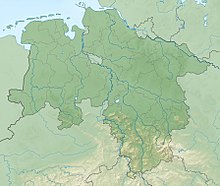Weser cliffs at Steinmühle
Coordinates: 51 ° 55 ′ 54 ″ N , 9 ° 27 ′ 51 ″ E
The Weser cliffs near Steinmühle are a bulging slope of the Weser in the Lower Saxony municipality of Pegestorf in the joint municipality of Bodenwerder-Polle in the Holzminden district . The cliffs lie west of Pegestorf am Mühlenberg in the southeast of the Ottensteiner plateau and are part of the nature reserve “ Mühlenberg bei Pegestorf ”.
History and description
The cliffs of the Prallhang are formed by shell limestone formations of the Mesozoic Era, into which the river meander of the Weser has cut since the last cold ages. The valley of the Weser corresponds to a geological fracture zone, which during the last three cold periods was covered by fluvial sediments (clay, sand, gravel) south of the glacier edge in the so-called glacier lake.
The rear side of the rebound slopes, which rise up to 100 meters from the river level on the face, is flatter in the profile and leads into side valleys and high altitudes, on which soil types are often found on loess, which was also deposited here as aeolian sediments during the last glacial periods. These areas have been used for arable farming since the beginning of human cultural history in the Weserbergland. Steeper terrain areas or terrain areas with narrow soil horizons, on which agricultural use does not make sense, are regularly used for forestry purposes. Details about the soil types in this landscape area can be found in the "Soil maps based on soil estimation" DGK5B (on a scale of 1: 5000) and on soil map BK25 No. 4022 - sheet Ottenstein (on a scale of 1: 25000).
West of the Weser there is an ascent of the mountain and hill country to the Ottensteiner plateau. The northwestern part of the Solling-Vogler Nature Park joins the east bank of the river, southeast of Dölme .
The impact slope areas are designated as a nature reserve "Mühlenberg bei Pegestorf" and are partly part of the FFH area of the same name . The protected areas as well as parts of the opposite east bank of the Weser also belong to the EU bird sanctuary "Sollingvorland".
In the area of the impact slope itself, there are AC v -C profiles on calcareous bedrock, such as rendzines .
Directly behind the current route of the B 83 , the partly very steep cliffs of the Prallhang rise, which are therefore only partly covered with vegetation.
The terracing of the river profile in front of the impact slope is spatially very narrow due to the history of its origin. The course of the river Weser corresponds in this area to a sequence of impact slopes on the meandering outer sides of the river.
Morphologically, the landscape can be assigned to the so-called Germanotypic fracture plate tectonics, which is characterized by the formation of layers of hills and mountains in the Weserbergland.
Habitat for bird species
The cliffs of the Prallhang offer numerous rare bird species breeding and nesting opportunities: a population of eagle owls has been found in the Prallhang for decades.
swell
- Füchtbauer, H. (1988): Sediments and Sedimentary Rocks
- Loucks, RG & Sarg, JF (1993): Carbonate sequence stratigraphy. - Amer. Assoc. Petro. Geol. Mem.
- Tucker, ME & Wright, VP (1990): Carbonate sedimentology. - Blackwell
- Wilson, JL (1975): Carbonate facies in geologic history. - Springer
- Soil mapping instructions. 4th edition, p. 182 (1994): published by the Federal Institute for Geosciences and Raw Materials and the Geological State Offices, Hanover
- see. also: Daily Anzeiger Holzminden - TAH, edition of August 11, 1995: Zweckverband Solling-Vogler inaugurated a bird watching hut
- Soil maps based on the soil estimate DGK5B (on a scale of 1: 5000) and on the soil map BK25 No. 4022 - sheet Ottenstein (on a scale of 1: 25000)
- Hansjörg Dongus, The basic geomorphological structures of the earth (1980), Teubner ( ISBN 3-519-03418-2 )
Web links
Individual evidence
- ↑ Füchtbauer, H. (1988): Sediments und Sedimentgesteine
- ^ Loucks, RG & Sarg, JF (1993): Carbonate sequence stratigraphy. - Amer. Assoc. Petro. Geol. Mem.
- ^ Tucker, ME & Wright, VP (1990): Carbonate sedimentology. - Blackwell
- ^ Wilson, JL (1975): Carbonate facies in geologic history. - Springer
- ↑ Hansjörg Dongus: Die Geomorphologische Grundstruktur der Erde (1980), Teubner ( ISBN 3-519-03418-2 ): p. 116f, p. 119, p. 144, p. 145, p. 146–154
- ↑ DGKB5 and BK25 of sheet 4022, Ottenstein (1988)
- ↑ Soil-scientific mapping instructions. 4th edition, p. 182 (1994): published by the Federal Institute for Geosciences and Raw Materials and the Geological State Offices, Hanover



